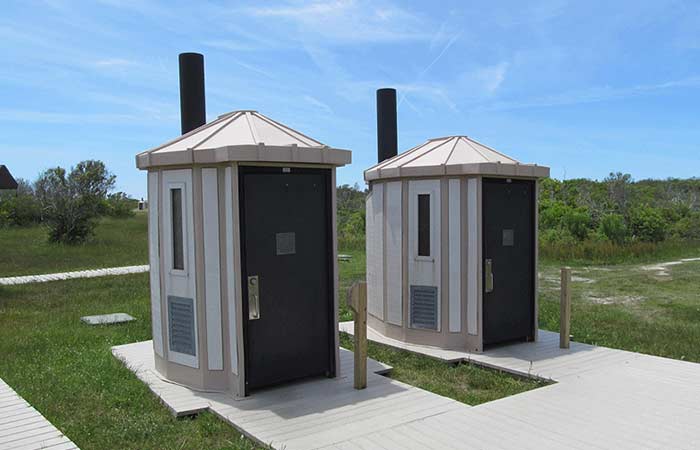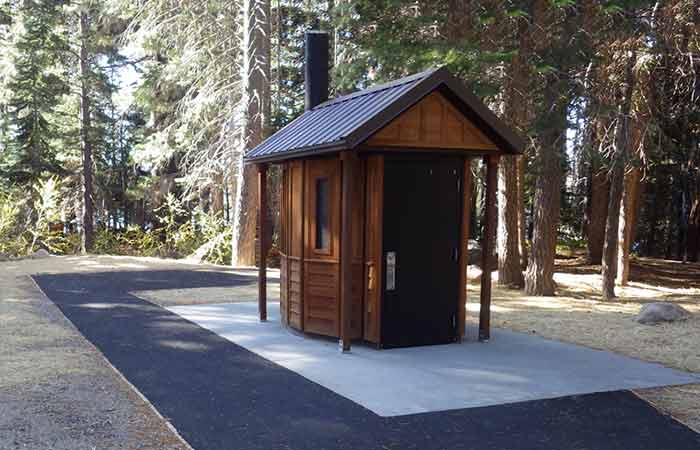Vault Toilet – What it is, How it Works, Pros & Cons
Vault toilets are some of the most common waterless toilets you probably have seen in public areas. Their main advantage is a reduction in the amount of water used and having very little environmental pollution. They also use the least amount of energy compared to flushing toilets.
If constructed properly, this type of toilets can be very convenient in that they can be odorless, easy to use and can be set up in a short period of time. However, they’re a quite of challenge when it comes to managing the vault waste.
Following are details on what exactly they are, how they work, pros and cons and more.
What is a Vault Toilet?
Vault toilets are a type of toilets that don’t use water or flushing and they store waste in a large airtight container located underground.
The ‘vault’ in vault toilet refers to the underground container. This type of toilet is best suited to areas with little water like public spots, campgrounds, parks and recreational areas.
Approved by the ADA, they were created by the U.S. Forest Service to reduce dependence on American standard toilets.

They’re easy to construct and can be made from cross-linked polyethylene, plastic, reinforced concrete or wooden frames. They have proven to be very durable with the most common type being made of polyethylene.
Vault toilets have a low risk of pollution given that the materials used to construct them rarely crack. Having a more portable vault toilet such as those made from plastic materials makes them lighter and more portable to use. Other waterless toilets include composting toilets, pit toilets and bag toilets.

How does a Vault Toilet Work?
A typical vault toilet will consist of two parts namely the vault which is dug into the ground and the upper part which looks like a booth. These toilets are unisex in design and can be set up in a short time for events or other activities. The vault in the ground can have a capacity of anything from 1,000 to 13,000 gallons.
In constructing a vault toilet, the ground is dug to accommodate the vault in size and shape. The vault is then buried in the ground with the top being covered with a slab to give it stability.
For the best flow of wastes, the toilet is usually constructed on a slope. When constructing the slab, a structure is connected to the slab to provide a connection to the vent pipe. The top part (the booth) is then constructed on top of the slab.
In this setup, the vault can be emptied by the municipal council or other service when the vault is near full. Depending on the size of the vault and the rate of usage, most vault toilets are emptied either once a week or every two weeks.
When it comes to controlling odors from the toilet, it depends on a few external factors to get it right. First, the vent has to be taller than the roof of the toilet booth. Besides that, you need the wind to carry away the stench or else it’ll simply cloud around the toilet or collect in a building or other structure close by. Wind will generally create pressure which will force the stench away from the toilet.
Other methods for venting the vault toilets include:
- Putting a flame at the vent to burn the odors out of the fumes from the toilet.
- Long underground pipes can be used to move the waste to places far away from the toilet. This is used mostly for vault toilets that are permanent in nature.
- The stench in the odor, made of ammonia and hydrogen sulphide, can be converted to odorless nitrogen gas with the addition of an organic filler to the waste.
- Activated carbon can also be added to the waste to remove the odor from the toilet fumes.
Another important aspect to controlling the stench from a vault toilet is the availability of heat on the vent at the roof of the toilet. Usually, the heat from the sun is enough for this purpose.
When the top of the vent is heated, it will quickly force the foul odor out. As hot air is lighter than cold air, the heated air quickly rises upwards and away from people. You may have noticed that you smell sewage gases on cold days than on hotter ones.
Pros
Some of the benefits of using a vault toilet include the following:
Conserve water
They don’t need running water to work making them highly cost effective. In fact, this aspect is the main reason they’re favored over flushing toilets in most places.
High level of privacy
Given that vault toilets are single units, only one person is allowed to use them at a single time. For this reason, they provide a high level of privacy to the user. They are also large enough for a change of clothes or other activity you can’t carry out in public.
Provide convenience
It’s easy to find a vault toilet wherever you are be it in the park or at an event. This eliminates the need to look for a toilet away from your place of work or event.
Flexible
With vault toilets, you can add a lot of other features that they don’t normally come with. For example, you can add lights and sanitizer machines on these toilets to improve their usage.
Cost-effective and easy to maintain
The materials and skills needed to construct a vault toilet are quite commonplace and will thus cost much less and less time to construct as well. They do not water…no water bills!
As for maintenance, you only need to wash it regularly and keep draining the waste on the regular.
Highly portable
The plastic type of vault toilets can be used many times by simply washing them then moving them to new locations. This portability makes them readily available for events and in public locations.
Cons
The downsides to using vault toilets include the following:
Need heat for proper working
When the vent lacks heat at the top, the air-cleaning process will not be effective. This can be caused by cloudy weather, rain, crowds or even shade from trees and buildings.
Ventilation systems may fail
Although uncommon, there are cases where the vault toilets’ ventilation systems fail. In such a case, the air around the toilet will be filled with a bad odor.
Require a consistent cleaning routine
Given that vault toilets don’t use water for flushing, they require constant washing to keep them clean. This can be quite difficult since most parks and other locations these toilets are used don’t usually have the amount of water needed. However, this water is less than what would have been used when flushing the toilet.
Waste management is difficult
With vault toilets being small units, it can be hard managing waste since they quickly fill up especially when in places with a large number of people. Beyond that, they can get clogged making it hard to unclog them without taking them apart. This can be quite costly.
At times, the riser can expose the waste making them quite unsightly.
Not all types are movable
While vault toilets are praised for their portability, it is the plastic type that are the most mobile since they be easily cleaned up and transferred to another location. The other types aren’t so movable.
How best to Prepare for using Vault Toilets
When you’re out camping and have to use a vault toilet, you need to put the following aspects into consideration:
There may be insects in the toilet
Some insects such as bees, spiders and mostly flies frequent vault toilets. However, this is quite rare and you may only see a few flies there. With the proper level of cleanliness, flies and most insects are rare to find around these toilets.
Avoid throwing trash in the vault toilet
Vault toilets are built for excreta and nothing more. When people dump solid objects into the vault such a tampons, diapers and wet wipes, they block the toilet and can require breaking down the toilet to unblock it. Even worse, it’ll render the toilet unusable requiring you and other users to seek a toilet elsewhere.
Keep your things safe
Unless you have a car around or a friend to take care of your belongings as you take care of some other business in the vault toilet, you should go into the toilet with your precious backpack. Otherwise, it’ll be stolen. Even with the car, lock it before heading into the toilet vault.
Use your own toilet paper
In most camps and events, there is toilet paper in the vault toilets. However, given the high number of people using these toilets, toilet paper runs out quite fast. You might thus find yourself embarrassed when you use the toilet and don’t see the toilet paper. For this reason, carry some into a vault toilet.
Have a hand sanitizer close by
While you might be lucky to get a vault toilet complete with a handwashing or sanitization booth, some may not have them. Instead, walk around with a hand sanitizer you can clean your hands with after using the toilet.
FAQs
Do Vault Toilets Flush?
No. Vault toilets don’t flush because they do not need water to work. The underground tank aka the vault holds the waste until it is emptied.
Do vault toilets smell?
Vault toilets do not smell much when well-vented but sometimes wind is need to carry away the odor.
Pit toilet vs a vault toilet – Differences?
The first difference is that, while vault toilets collect the waste in a container, the waste goes to the soil directly in a pit latrine. Pit latrines are also quite hard to fill as the waste is absorbed by the soil easily. It’s also hard to keep flies away from pit latrines given that the waste is rarely removed.
Vault toilet vs porta potty – Differences?
While vault toilets aren’t flush toilets, porta potties are flush toilets as they have a flush similar to an American standard one. Also, porta potties have smaller vaults compared vault toilets hence need more frequent emptying.
Further Reading